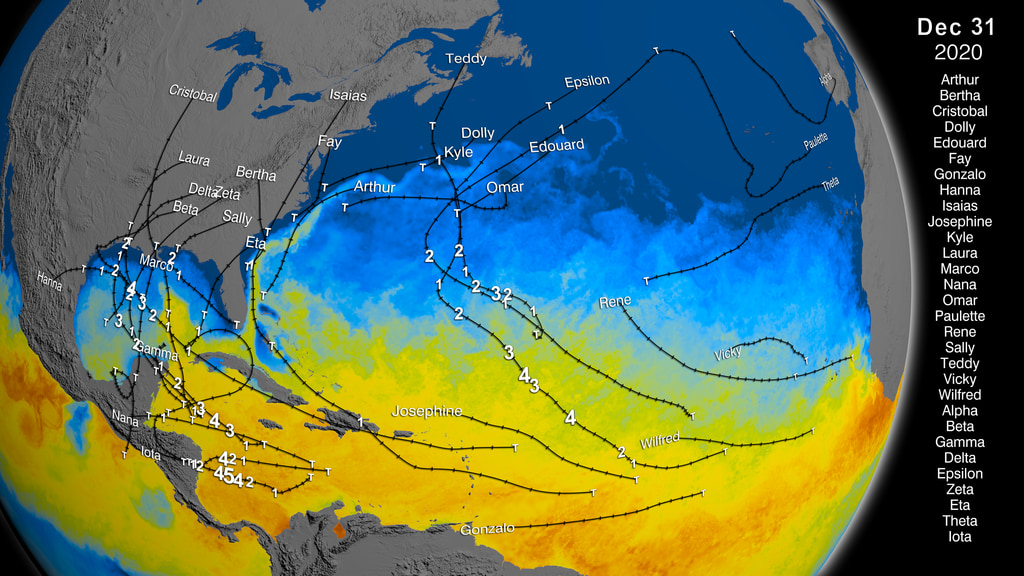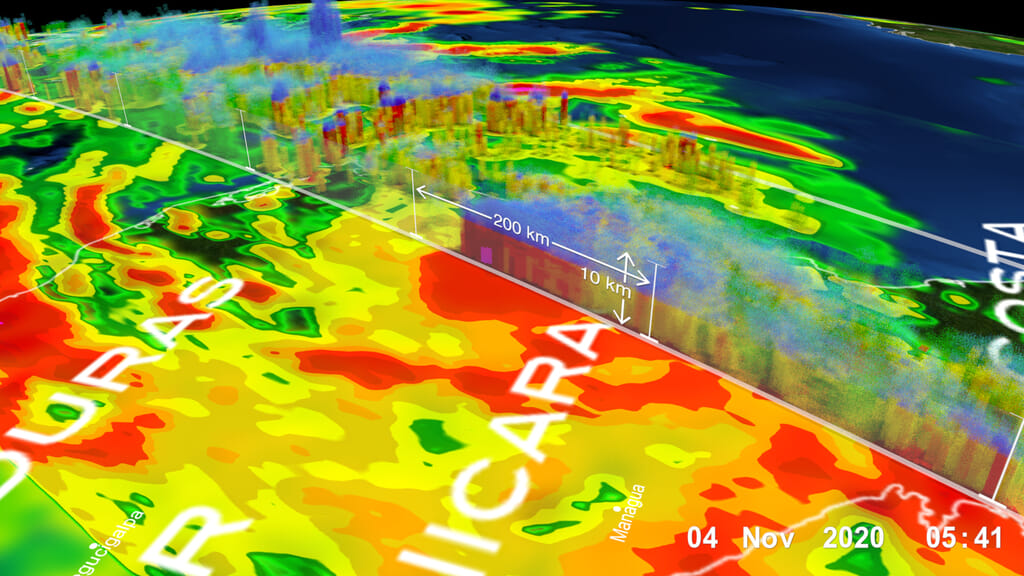A newer version of this visualization is available.
NASA/JAXA GPM Satellite Eyes Eta Over Florida
Tropical Storm Eta making landfall over the Florida Keys on Sunday, November 8, 2020 at approximately 23:11Z (11/9/2020 4:11 EST).
After striking the northeast coast of Nicaragua as a powerful Category 4 storm back on November 3, Hurricane Eta weakened rapidly over Central America but still brought major flooding and triggered numerous landslides that so far have resulted in at least 250 fatalities across the region, according to media reports. Eta was down to a tropical depression when the center re-emerged over the northwestern Caribbean on the evening of November 5. An upper-level trough over the Gulf of Mexico first steered Eta northeastward towards Cuba on the 6th. Because it was disorganized after its trek across Central America, it took time for Eta to respond to the still warm waters of the western Caribbean, but by the morning the November 7, Eta had once again reached tropical storm intensity. Eta crossed central Cuba on the morning of the 8th as a strong tropical storm before emerging over the Florida Straits. The same upper-level trough now began to draw Eta back towards the northwest in the direction of the Florida Keys.
This data visualization provides a detailed look into Eta courtesy of the GPM Core Observatory satellite, which overflew the storm at 11:41 p.m. EST on November 8 (4:41 UTC November 9), just after the center made landfall on Lower Matecumbe Key in the Florida Keys. Rainfall rates derived from the GPM Microwave Imager (GMI) and Dual-Frequency Precipitation Radar (DPR) show that Eta had a rather large but well-defined eye immediately surrounded by very heavy rain rates (shown in red colors) north and east of the center that are part of the eyewall. GPM also shows that the bulk of the rain associated with Eta was contained in several rainbands wrapping across the Florida peninsula well north of the center. Tall cloud towers associated with areas of deep convection (highlighted by the blue isosurface) detected by the DPR show where precipitation-sized particles extended upward within these thunderstorms that are fueling Eta’s circulation. At the time of the GPM overpass, Eta was a strong tropical storm with maximum sustained winds reported at 65 mph by the National Hurricane Center (NHC).
After passing through the Florida Keys, Eta turned southwest and weakened slightly as a result of ingesting some drier air. The latest NHC forecast suggests that Eta could meander over the southeast Gulf of Mexico north of western Cuba for a day or so before drifting slowly northward towards the northern Gulf Coast.
Eta is the 28th named storm of 2020 which beats the 2005 record for the most named storms in a single hurricane season. (See 27 Storms: Arlene to Zeta for a summary of the 2005 hurricane season).
GPM data is archived at https://pps.gsfc.nasa.gov/

Color bar for frozen precipitation rates (ie, snow rates). Shades of cyan represent low amounts of frozen precipitation, whereas shades of purple represent high amounts of precipitation.

Color bar for liquid precipitation rates (ie, rain rates). Shades of green represent low amounts of liquid precipitation, whereas shades of red represent high amounts of precipitation.
Credits
Please give credit for this item to:
NASA's Scientific Visualization Studio
-
Data visualizers
- Alex Kekesi (Global Science and Technology, Inc.)
- Greg Shirah (NASA/GSFC)
-
Scientists
- George Huffman (NASA/GSFC)
- Dalia B Kirschbaum (NASA/GSFC)
-
Producer
- Ryan Fitzgibbons (USRA)
-
Writer
- Stephen Lang (SSAI)
Release date
This page was originally published on Monday, November 9, 2020.
This page was last updated on Monday, January 6, 2025 at 12:17 AM EST.
Missions
This page is related to the following missions:Series
This page can be found in the following series:Datasets used
-
Rain Rates (Surface Precipitation) [GPM: GMI]
ID: 822Credit: Data provided by the joint NASA/JAXA GPM mission.
See all pages that use this dataset -
Volumetric Precipitation data (Ku) [GPM: DPR]
ID: 830Credit: Data provided by the joint NASA/JAXA GPM mission.
See all pages that use this dataset -
IMERG
ID: 863This dataset can be found at: http://pmm.nasa.gov/sites/default/files/document_files/IMERG_ATBD_V4.4.pdf
See all pages that use this dataset -
[GOES-16: ABI]
ID: 978Advanced Baseline Imager (ABI) has 16 spectral bands, including two visible channels, four near-infrared channels and ten infrared channels. It is nearly identical to the imagers on Himawari 8 and Himawari 9.
See all pages that use this dataset
Note: While we identify the data sets used on this page, we do not store any further details, nor the data sets themselves on our site.



